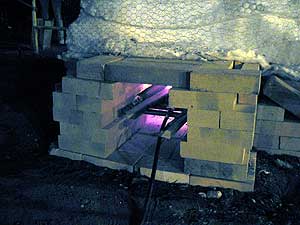|
Audio
Photos
More from MPR
Resources
Your Voice
|
Fired up inside
October 7, 2004
 |
| The glow of the fire early on presages the glow Nina Hole and her team expects when they unwrap the sculpture they are firing on the University of Minnesota campus. (MPR photo Euan Kerr) |
Minneapolis, Minn. — A fire at night exerts a primal attraction for many people. A gas burner ups the ante somehow, adding a slight sense of danger. The burner in question rumbles in the blazing fire pit under a sculpture-in-the-making. (See Flash presentation)
 | |||
The heat rises inside the large looming shape. It's wrapped in white fire-blankets held in place with chickenwire. It's at least twice the height of its creator, Nina Hole.
She walks around, chatting while checking the fire, and the digital thermometer. The team built the piece over 10 days using techniques Nina Hole developed.
"I have done it for about 10 years," she says. "It is because I always wanted to be building larger than my kiln was. So I tried to think about ways to build out in the free."
She found ways of working the clay so it supports its own weight. There are thousands of pounds of clay molded in this sculpture. Hole won't talk much about what it will look like when finished. She says it has elements of a skyscraper about it, and references both to Minnesota, and to her home in Denmark. She says she does one or two of these pieces a year, but she is careful about predicting how the sculpture will turn out.
 | |||
When asked if she's confident, she laughs aloud.
"No! I am never confident before we are at the end. No, I just have to stay really uncertain."
A lot of different things could happen. The heating starts slowly. The idea is to raise the temperature inside just 25 degrees centigrade every hour. Heat it too quickly and the moisture in the clay could rapidly expand. In the worst case scenario, the sculpture could explode. That is unlikely, but uneven heating could change the look of the glazes coating parts of the piece.
What Nina Hole is focusing on now is how the piece will look when they strip off the fire blanket and leave the piece glowing hot against the evening sky. She describes it as the height of fulfillment for a ceramic artist. It's addictive, she says.
"Nothing ever gets so beautiful as if it is glowing hot like that," she says. "So it is a moment that you have to enjoy, and then it goes away!" she laughs again.
When asked if this is ceramic or performance, she answers simply: "Yes it is. It is both."
 | |||
Several people working on the project say the process is as important as the finished piece. Most of the dozens of volunteers are local, but one woman Shirley Shepherd has come from a little further afield. She's an Australian, now living in the north of England.
Shepherd has seen Hole work before and says the moment when the piece is revealed is spectacular, and for the artists, a little nerve-wracking.
"You don't know what is underneath that blanket," she says. "It could have cracked. Parts of it could have come off. And you really don't know. And you cut the blanket off and it's just burning. Everything is red-hot and you can see if it's still in one piece. Then when it's cooled down you think 'Have the glazes worked the way they're supposed to? Have the colors come off the way they are suppose to?' Because that's what's going to be left for the next X number of years."
Which raises a question. What's going to happen to the finished piece? Artist Nina Hole says she would be happy for it to stay where it is now, on a piece of scrubland across the street from the University of Minnesota's new fine arts building. But the folks at the Northern Clay Center, which is sponsoring her visit, worry about the freeze and thaw of a few Minnesota winters. They'd love to talk with anyone who could give it a home inside.
|
News Headlines
|
Related Subjects
|
